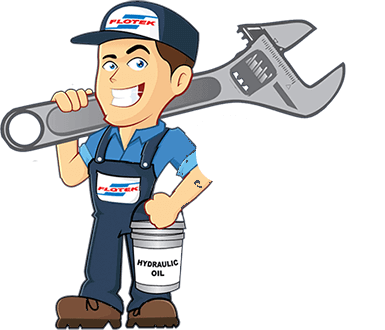How Does Hydraulic Pump Work?
To get an idea of how a hydraulic pump works, it can be explained in four words: “liquid under pressure.” The liquid under pressure is called hydraulics and the machine that creates the pressure to power various machines or tools is a hydraulic pump.
A basic hydraulic pump has a cylinder inside with a piston going up and down inside the cylinder, creating high pressure through [a] fluid known as hydraulic oil. There is always a reservoir where the fluid is held and slowly released into the pump when it’s time to create the pressure needed for machinery.
Different Types of Hydraulic Pumps
There are three different types of hydraulic pumps: gear, vane, and piston. Each type has a small difference that makes them better for certain tasks than others.
Gear pumps are the most commonly used type of pump for hydraulic machinery. Gear pumps have two meshing gears that rotate at different speeds to create pressure.
The speed difference between the gears is what creates the ability to turn a shaft, which runs whatever hydraulic machinery needs to be run. Gear pumps are usually placed near whatever machines they are powering and can be easily found on anything from cranes to bulldozers.
Piston pumps are one of the most widely used types of hydraulic pumps in the industry today. They are also known as “double-action piston pumps”. This means that they use a single input shaft to power two pistons, which move back and forth in their cylinders, each pushing fluid into or out of the opposite chamber. The advantage of this type of pump is that it allows fluid to be moved in two directions with only one rotating shaft.
A rotary vane-type hydraulic pump is a positive displacement (meaning it will produce the same output for any input) piston-based mechanism which transfers energy from one place to another. Driving fluid into and out of this device causes rotation, which can power most types of gears, cams, hydraulic cylinders, cranes, and so on. This is because the forces applied by this pump are directly proportional to the speed of rotation, which means it’s very efficient at transferring energy over many applications.
Why Do Hydraulic Pumps Fail and How Can You Avoid Them?
Many factors cause hydraulic power packs and pumps to fail. Understanding the causes of these failures can help you prevent them.
The most common cause of pump failure is lack of lubrication and proper oil maintenance. A properly maintained hydraulic system has a clean, lubricated circuit with a proper amount of fluid. The oil level should be checked at least once a month.
Overloading is another cause of hydraulic pump failure. A system that is used for more than its designed load can quickly fail due to overheating the hydraulic components.
Another common cause of premature pump failure is poor design or manufacture defects, poor installation, or poor material selection.
Finally, external factors can cause a system failure. Corrosion and erosion are two examples. A hydraulic pump should be housed in a place that offers adequate protection against corrosion. Erosion occurs when dirt enters the fluid stream through an improperly filtered system.
Why Should You Choose Flotek for Hydraulic Pump Repair?
If you are experiencing issues with your hydraulic pumps, call Flotek. We have a team of experienced technicians and engineers to provide expert repair services Australia-wide. Our company is committed to providing the best service for our clients and we guarantee that we can fix any problem in minutes! Call us now for more details.
Flotek is a leading provider of hydraulic pump repair services in Melbourne. As a customer-focused company, Flotek strives for complete customer satisfaction and will go the extra mile to ensure that all of your needs are met. With their team of technicians, they make you feel as comfortable and safe as possible throughout your experience.




